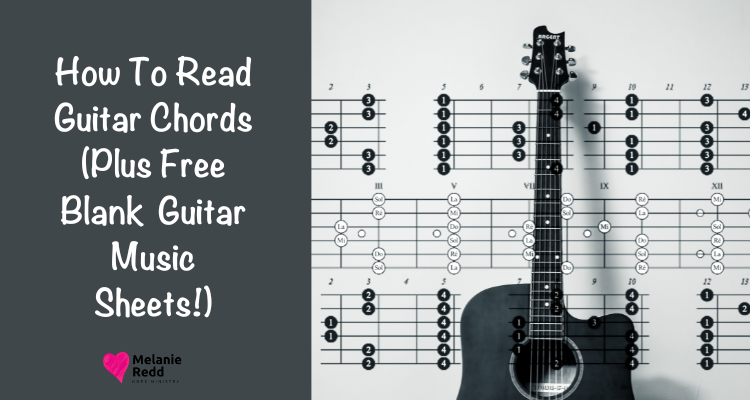How To Read Guitar Chords (Plus Free Blank Guitar Music Sheets!)

How To Read Guitar Chords (Plus Free Blank Guitar Music Sheets!)
Learning to read guitar chords can be intimidating for the beginner musician.
You may feel overwhelmed by all the symbols you still need to understand.
Yet, it does not have to be the case!
With enough practice and dedication, anyone can become a skilled guitarist. And so this guide will walk you through the basics of reading guitar chords.
Plus, you’ll get to have free blank guitar music sheets.
Learn the Basics of Music Theory
Learning the basics of music theory is essential to reading guitar chords. Well, it gives you the knowledge to understand what you’re playing. Plus, it allows you to develop your unique sound.
The best way to start learning about music theory is by understanding basic concepts, such as:
● Scales. Patterns of notes in every musical genre and essential to all melodic lines.
● Intervals. The distance between two notes. Also, they create harmony when played
together.
● Chords. Two or more notes played together at once.
Once you understand these concepts, you can begin applying them to your playing. Also, when reading chords, it’s essential to identify the symbols used for each.
For instance, a capital letter represents a major chord. Then, a lowercase letter symbolizes minor chords. Besides, numbers (usually between 0-7) say augmented or diminished chords.
On top of that, below are some tips to learn the basics of music theory.
1. Understand the basics of rhythm and timing. Before diving into learning guitar chords, it’s crucial to understand timing. Learn the fundamentals such as whole notes, half notes, quarter notes, and eighth notes. Knowing the different types of time signatures, like 4/4 and 3/4, is also essential for chord progressions.
2. Learn chord theory. To understand chords, you need to learn about scales and intervals.
Once you know major scales and their relative minor counterparts, you can start building chords. As you work through each step, use blank chord diagrams as a visual aid to see the location of notes on the fretboard.
3. Use blank chord charts for reference. Every song has its own unique set of guitar chords that go along with it. To play any song, you’ll need access to its corresponding chord charts or tab sheets.
Understand Blank Chord Diagrams and Notations
First things first, what are blank chord diagrams? Well, chord diagrams represent the fretboard with strings depicted horizontally across the page. Also, it includes basic symbols to represent notes to help musicians visualize.
Aside from that, musicians need to understand guitar sheet notation to read chords properly.
A notation typically consists of two components, including:
1. Staff notation. A series of five lines that represent different pitches. Plus, it helps musicians identify which note to play for each string.
2. Tablature. Numbers on a specific string indicate which fret you should play. Besides that, it will assist you in how long you should hold each note during playback.
Also, start by familiarizing yourself with some basic symbols in a blank sheet of music like:
Quarter notes (look like small filled-in circles)
Eighth notes (similar but have an added flag attached)
Rests (squiggly line shapes)
Sharps (# symbol)
Flats (b symbol)
Practice Sight-Reading From Blank Guitar Sheet Music or Staff Paper
Learning to sight-read can give you an advantage in almost any musical situation. Here are some reasons why sight reading music paper can help your guitar playing:
● Get familiar with musical notation. Sight-reading blank sheet music helps familiarize the symbols and notation in written music. This way, it is much easier to understand and follow any piece of written music you come across.
● Learn different rhythms. Allow you to familiarize yourself with different rhythms in a musical language. Plus, understanding different rhythmic patterns will make it easier to write music.
● Develop better hand coordination. Your hands become increasingly coordinated as you practice sight-reading from blank staff paper. This improved coordination helps increase your speed and accuracy when playing.
● Improve memory retention. Enhance your recall of what you have read by associating each note with its fret.
● Learn new songs quickly. Quickly identifying notes on the fretboard makes it much easier to learn new songs. And it is likely to make fewer mistakes due to incorrect
fingering choices.
As you become more comfortable, slowly increase the complexity of the pieces you choose.
Access Free Blank Guitar Sheet Music
Free blank guitar sheet music can be a great way to get up and running for those just starting with guitar lessons. And with these sheets, you can see what’s going on with each note when you play. Plus, you’ll become accustomed to reading standard notation in a much shorter time.
On top of that, many websites offer extra tools, such as interactive fretboards. This way allows you to comprehend the concept of chords and progressions visually.
Plus, blank guitar sheet music can range from a single line of notes or chords to full multi-part arrangements. You’ll find plenty of online resources that offer printable PDFs and digital software versions.
So, download free blank guitar music sheets now.
Were you encouraged by what you read?
Then, would you share this article with a friend, co-worker, or family member?
Or, maybe you can send it to a friend or family member?
This blog occasionally uses affiliate links and may contain affiliate links. Additionally, Melanie Redd is a participant in the Amazon Services LLC Associates Program. This is an affiliate advertising program designed to provide a means for sites to earn advertising fees. These are earned by advertising and linking to amazon.com. Also, for more on my disclosure policy, click HERE.
© Melanie Redd and Hope Ministry, 2023. Unauthorized use and/or duplication of this material without express and written permission from this blog’s author and/or owner is strictly prohibited. Further, excerpts and links may be used, provided that full and clear credit is given to Melanie Redd and Hope Ministry, LLC. Please give appropriate and specific directions to the original content.



0 Comments